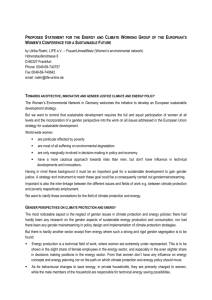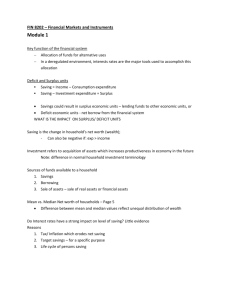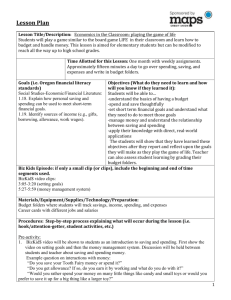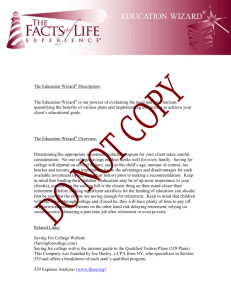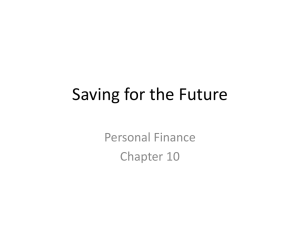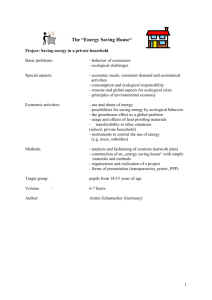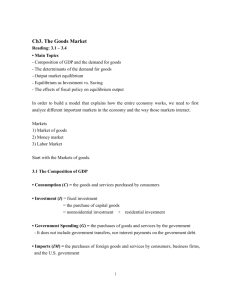The Psychology of Saving - Jackson & Peck Financial Group, LLC
advertisement
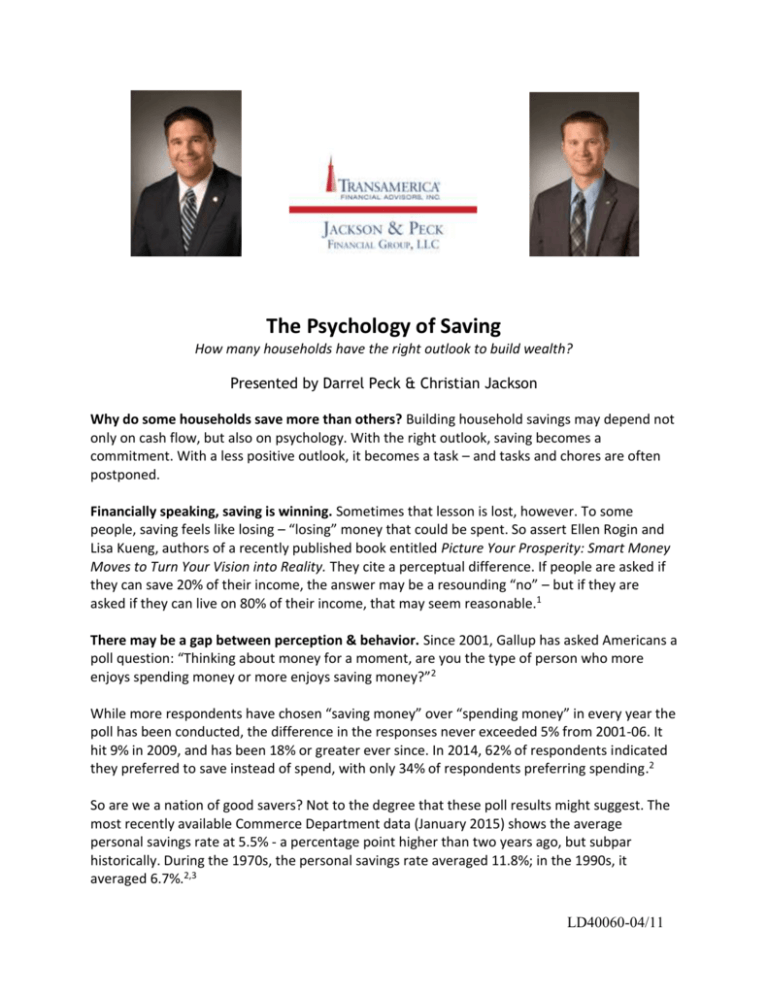
The Psychology of Saving How many households have the right outlook to build wealth? Presented by Darrel Peck & Christian Jackson Why do some households save more than others? Building household savings may depend not only on cash flow, but also on psychology. With the right outlook, saving becomes a commitment. With a less positive outlook, it becomes a task – and tasks and chores are often postponed. Financially speaking, saving is winning. Sometimes that lesson is lost, however. To some people, saving feels like losing – “losing” money that could be spent. So assert Ellen Rogin and Lisa Kueng, authors of a recently published book entitled Picture Your Prosperity: Smart Money Moves to Turn Your Vision into Reality. They cite a perceptual difference. If people are asked if they can save 20% of their income, the answer may be a resounding “no” – but if they are asked if they can live on 80% of their income, that may seem reasonable.1 There may be a gap between perception & behavior. Since 2001, Gallup has asked Americans a poll question: “Thinking about money for a moment, are you the type of person who more enjoys spending money or more enjoys saving money?”2 While more respondents have chosen “saving money” over “spending money” in every year the poll has been conducted, the difference in the responses never exceeded 5% from 2001-06. It hit 9% in 2009, and has been 18% or greater ever since. In 2014, 62% of respondents indicated they preferred to save instead of spend, with only 34% of respondents preferring spending.2 So are we a nation of good savers? Not to the degree that these poll results might suggest. The most recently available Commerce Department data (January 2015) shows the average personal savings rate at 5.5% - a percentage point higher than two years ago, but subpar historically. During the 1970s, the personal savings rate averaged 11.8%; in the 1990s, it averaged 6.7%.2,3 LD40060-04/11 What reminders or actions might help people save more? Automated retirement plan contributions can assist the growth of savings, and are a means of paying oneself first. There is the envelope system, wherein a household divides its paycheck into figurative (or literal) envelopes, assigning X dollars per month to different packets representing different budget categories. When the envelopes are empty, you can spend no more. The psychology is never to empty the envelopes, of course – leaving a little aside each month that can be saved. Households take an incremental approach: they start by saving one or two cents of every dollar they make, then gradually increase that percentage, household expenses permitting. Frugality may help as well. A decision to live on 70% or 80% of household income frees up some dollars for saving. Another route to building a nest egg is to invest (or at least save) the accumulated consumer savings you realize at the mall, the supermarket, the recycling center – even pocket change amassed over time. How many households budget like businesses? Perhaps more should. A business owner, manager, or executive may realize savings through this approach. Take it line item by line item: spending $20 less each week at the supermarket translates to $1,040 saved annually. Working with financial professionals may encourage greater savings. A 2014 study on workplace retirement plan participation from Natixis Global Asset Management had a couple of details affirming this. While employees who chose to go without input from a financial professional contributed an average of 7.8% of their incomes to their retirement plan accounts, employees who sought such input contributed an average of 9.5%. The study also learned that 74% of the employees who had turned to financial professionals understood how much money their accounts needed to amass for retirement, compared to 54% of employees not seeking such help.4 Saving money should make anyone feel great. It means effectively “paying yourself” or at least building up cash on hand. A household with a save-first financial approach may find itself making progress toward near-term and long-term money goals. This material was prepared by MarketingPro, Inc., and does not necessarily represent the views of the presenting party, nor their affiliates. This information has been derived from sources believed to be accurate. Please note - investing involves risk, and past performance is no guarantee of future results. The publisher is not engaged in rendering legal, accounting or other professional services. If assistance is needed, the reader is advised to engage the services of a competent professional. This information should not be construed as investment, tax or legal advice and may not be relied on for the purpose of avoiding any Federal tax penalty. This is neither a solicitation nor recommendation to purchase or sell any investment or insurance product or service, and should not be relied upon as such. All indices are unmanaged and are not illustrative of any particular investment. Citations. 1 - businessinsider.com/mental-trick-save-money-2015-1 [1/27/15] 2 - gallup.com/poll/168587/americans-continue-enjoy-saving-spending.aspx [4/21/14] 3 - bea.gov/newsreleases/national/pi/pinewsrelease.htm [3/2/15] 4 - bostonglobe.com/business/2014/09/06/advice-seekers-save-more-study-finds/dJmUUXz78twO9OxLcRTqdN/story.html [9/6/14] LD40060-04/11
